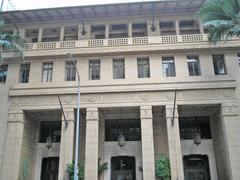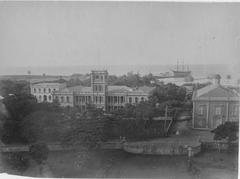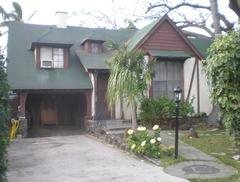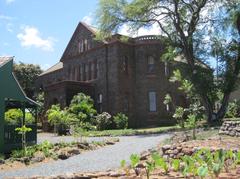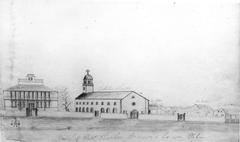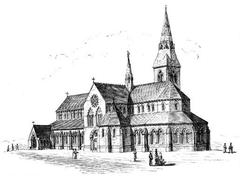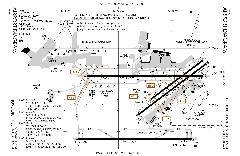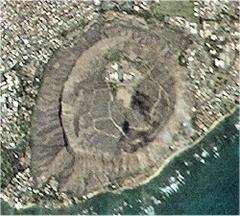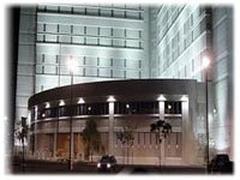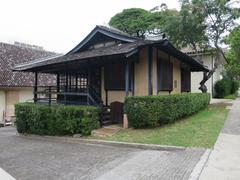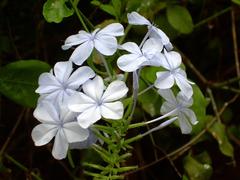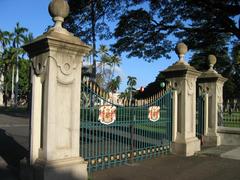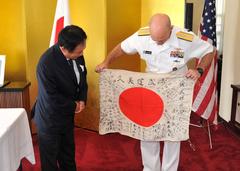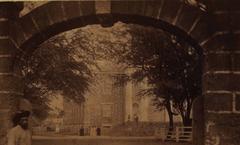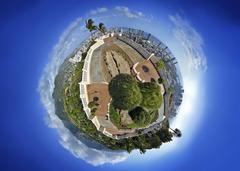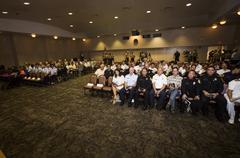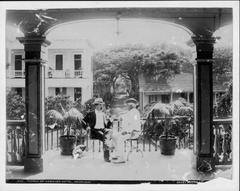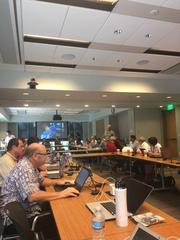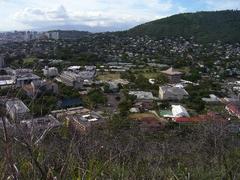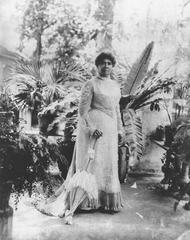
Honolulu Hale Visiting Hours, Tickets, and Historical Sites Guide
Date: 04/07/2025
Introduction
Nestled in the heart of downtown Honolulu, Honolulu Hale stands as a distinguished emblem of civic governance and cultural heritage. Serving as the official seat of government for the City and County of Honolulu since 1928, this architectural masterpiece offers visitors an immersive journey into the island’s political history, community spirit, and artistic legacy. Designed by notable architects such as C.W. Dickey and Hart Wood, Honolulu Hale’s Italianate Spanish Colonial Revival style, combined with Hawaiian cultural symbolism, creates a structure that reflects Oʻahu’s multicultural identity and tropical environment.
Beyond its governmental roles—housing the mayor’s office, city council chambers, and key administrative departments—Honolulu Hale is a vibrant center for community events, rotating art exhibitions, and civic engagement. Its location at 530 South King Street places it within walking distance of historic landmarks such as ʻIolani Palace, Aliʻiōlani Hale, and Kawaiahaʻo Church. Whether you’re an architecture enthusiast, history buff, or first-time visitor, this guide provides essential information on visiting hours, tickets, accessibility, nearby attractions, and travel tips to ensure a memorable experience.
For up-to-date details and event schedules, consult the official City and County of Honolulu website and the Historic Hawaii Foundation.
Table of Contents
- Historical Development of Honolulu Hale
- Architectural Significance and Design Influences
- Visiting Information: Hours, Tickets, Accessibility
- Special Exhibitions: ʻUmeke Lāʻau
- Nearby Attractions and Itinerary Planning
- Practical Visitor Tips
- Frequently Asked Questions (FAQ)
- Preservation and Community Engagement
- References and Resources
Historical Development of Honolulu Hale
The need for a centralized civic building arose in the early 20th century as Honolulu’s municipal responsibilities expanded. Previously, city offices were scattered, making governance inefficient. In response, a team of prominent architects including C.W. Dickey, Hart Wood, Robert Miller, and Rothwell Kangeter & Lester collaborated to design Honolulu Hale. Construction began in 1927, and the building officially opened in 1929 at its present site on South King Street.
Honolulu Hale was recognized as a contributing property to the Hawaii Capital Historic District and listed on the National Register of Historic Places in 1978. Over the decades, it has hosted pivotal civic events, government milestones, and cultural celebrations, embodying the dynamic spirit and heritage of Honolulu.
Architectural Significance and Design Influences
Spanish Colonial Revival and Hawaiian Motifs
Honolulu Hale’s architecture is a blend of Italianate Spanish Colonial Revival style and distinctive Hawaiian touches. The building features stuccoed walls, red-tiled roofs, arched windows, and wrought-iron details—elements chosen for their durability and ability to harmonize with Hawaii’s climate. Its grand loggia and interior courtyard, inspired by Florence’s Bargello, provide natural light and ventilation while fostering a sense of openness and community.
Artistic Elements and Interior Spaces
Inside, visitors are greeted by an open-air courtyard adorned with a central fountain, lush greenery, and tiled walkways. Murals and frescoes by Einar Peterson, intricate stonework by Mario Valdastri, and Hawaiian wood carvings enrich the building’s artistic heritage. These features not only beautify the space but also offer insight into the island’s cultural narratives.
Preservation and Expansion
In 1951, two three-story wings were added to accommodate expanding municipal needs, with careful attention paid to architectural consistency. Ongoing preservation efforts by the Historic Hawaii Foundation ensure that Honolulu Hale remains both functional and historically significant.
Visiting Information: Hours, Tickets, Accessibility
Location and Hours
- Address: 530 South King Street, Honolulu, HI 96813
- Open: Monday to Friday, 7:45 AM – 4:30 PM (Closed on weekends and public holidays)
Tickets and Admission
- Admission: Free for all visitors; no tickets required for general entry.
- Guided Tours: Offered occasionally during special events or by arrangement with the Mayor’s Office of Culture and the Arts. Advance booking may be required for group tours.
Accessibility
- Wheelchair Accessible: Ramps, elevators, and accessible restrooms are available.
- Service Animals: Permitted.
- Visitor Facilities: Restrooms and water fountains are located on the main floor.
Photography and Etiquette
- Photography: Allowed in public areas. Please be respectful during meetings or official events.
- Dress Code: Modest attire is recommended as this is an active government building.
Contact
- Phone: (808) 768-6622
Special Exhibitions: ʻUmeke Lāʻau
From June 2024 through May 4, 2025, Honolulu Hale hosts the monumental Native Hawaiian art installation, ʻUmeke Lāʻau, by Meleanna Aluli Meyer. This 22-foot-diameter wooden calabash serves as a gathering space for up to 30 people and features an immersive audio experience with the 38,000 names from the Kūʻē Petitions of 1897. The installation honors Native Hawaiian resilience and encourages community dialogue.
- Etiquette: Remove shoes before entering the installation.
- Reservations: Groups can reserve the space via an online form or by contacting [email protected] or (808) 768-6622.
- More Info: Hawaii News Now; University of Hawaiʻi News; Planetizen
Nearby Attractions and Itinerary Planning
Maximize your visit by exploring these nearby sites:
- ʻIolani Palace: The only royal palace in the U.S., featuring ornate interiors and royal artifacts. (Official Site)
- Aliʻiōlani Hale & King Kamehameha Statue: Home to the Hawaii State Supreme Court; the iconic statue is a prime photo spot.
- Hawaii State Capitol: Modernist architecture symbolizing the islands.
- Washington Place: Former governor’s mansion, available for tours by reservation.
- Honolulu Museum of Art: Renowned for its Pacific and Asian collections; free admission on select days.
- Foster Botanical Garden: Tropical plant collections and historic greenhouses.
- Chinatown: Vibrant markets, art galleries, and eateries; don’t miss the First Friday Art Walk.
- Aloha Tower: Harbor views from the free observation deck.
- Kakaʻako Waterfront Park: Oceanfront picnic areas and walking paths.
- Bishop Museum: Premier natural and cultural history exhibits.
- Hawaii Theatre: Restored neoclassical venue for concerts and plays.
- Puʻu ʻUalakaʻa State Wayside Park: Panoramic city views.
Practical Visitor Tips
- Public Transit: TheBus services downtown; several routes stop within walking distance.
- Parking: Metered street parking and public garages (Ali‘i Place, Capitol District) available; limited during peak hours.
- Best Times: Weekday mornings are quieter; event days are lively but busier.
- What to Bring: Photo ID (for certain events), water, camera, sunscreen, hat, and comfortable shoes.
- Cultural Etiquette: Remove shoes where indicated, greet with “Aloha,” and be respectful of local traditions.
- Weather: Expect tropical conditions; carry rain gear during wetter months.
Frequently Asked Questions (FAQ)
Q: What are Honolulu Hale’s visiting hours?
A: Monday to Friday, 7:45 AM to 4:30 PM, closed weekends and public holidays.
Q: Is there an admission fee?
A: No, entry is free for all visitors.
Q: Are guided tours available?
A: Tours are occasionally offered; check the official website for updates.
Q: Is Honolulu Hale wheelchair accessible?
A: Yes, the building is fully accessible.
Q: Where is Honolulu Hale located?
A: 530 South King Street, downtown Honolulu.
Q: What are the top nearby attractions?
A: ʻIolani Palace, Aliʻiōlani Hale, Washington Place, Hawaii State Capitol, and Chinatown.
Q: How do I reserve a visit to the ʻUmeke Lāʻau installation?
A: Reserve online via the Mayor’s Office of Culture and the Arts or contact them directly.
Preservation and Community Engagement
Honolulu Hale’s preservation reflects a commitment to both history and community. Its status within the Hawaii Capital Historic District mandates careful restoration and ongoing maintenance, led by city officials and groups like the Historic Hawaii Foundation. The building regularly hosts civic events, art exhibits, and public forums—inviting residents and visitors to participate in shaping the city’s future.
Annual events like Honolulu City Lights, Lei Day, and rotating art exhibitions foster a deep sense of community and cultural pride. Art installations such as ʻUmeke Lāʻau and events hosted in partnership with the Mayor’s Office of Culture and the Arts further reinforce Honolulu Hale’s role as a hub for indigenous and local voices.
References and Resources
- Historic Hawaii Foundation
- Honolulu City Council – Visiting Information
- HelloMondo – Honolulu City Hall
- Mayor’s Office of Culture and the Arts
- ʻUmeke Lāʻau Installation – Hawaii News Now
- University of Hawaiʻi News
- Planetizen: Monument to Resilience
Conclusion
Honolulu Hale remains a cornerstone of Honolulu’s historical and civic landscape. Its architectural elegance, cultural significance, and vibrant community events offer an inspiring window into the city’s past and present. With accessible visiting hours, free admission, and proximity to major historical sites, it is an essential stop for anyone seeking to understand the heart of Honolulu.
For the latest updates on hours, events, and tours, visit the City and County of Honolulu’s official pages and the Mayor’s Office of Culture and the Arts. Download the Audiala app for interactive tours and event notifications, and enhance your exploration of Honolulu’s living heritage.









